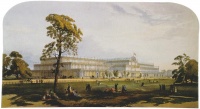Modern
From The Art and Popular Culture Encyclopedia
(Difference between revisions)
| Revision as of 05:30, 30 April 2021 Jahsonic (Talk | contribs) ← Previous diff |
Current revision Jahsonic (Talk | contribs) |
||
| Line 1: | Line 1: | ||
| - | [[Image:Trylon, Perisphere and Helicline (Samuel H. Gottscho).jpg|thumb|200px|The [[Trylon and Perisphere]], two [[Modernist architecture|modernistic structures]] at the [[1939 New York World's Fair|New York World's Fair of 1939-1940]]<br> | ||
| - | <small>Photo: [[Trylon, Perisphere and Helicline (Samuel H. Gottscho)]]</small>]] | ||
| [[Image:The Crystal Palace.jpg|thumb|left|200px|The usage of new materials such as [[iron]], [[steel]], [[concrete]] and [[glass]] is ascribed an important place in [[modern architecture]], with [[the Crystal Palace]] of [[1851]] considered as its first large scale use.]] | [[Image:The Crystal Palace.jpg|thumb|left|200px|The usage of new materials such as [[iron]], [[steel]], [[concrete]] and [[glass]] is ascribed an important place in [[modern architecture]], with [[the Crystal Palace]] of [[1851]] considered as its first large scale use.]] | ||
| {| class="toccolours" style="float: left; margin-left: 1em; margin-right: 2em; font-size: 85%; background:#c6dbf7; color:black; width:30em; max-width: 40%;" cellspacing="5" | {| class="toccolours" style="float: left; margin-left: 1em; margin-right: 2em; font-size: 85%; background:#c6dbf7; color:black; width:30em; max-width: 40%;" cellspacing="5" | ||
| Line 6: | Line 4: | ||
| "That is why, while conspicuously absent from the world of pagan antiquity, the idea of [[modern|modernity]] was born during the Christian Middle Ages." --''[[Five Faces of Modernity]]'' (1987) Matei Calinescu | "That is why, while conspicuously absent from the world of pagan antiquity, the idea of [[modern|modernity]] was born during the Christian Middle Ages." --''[[Five Faces of Modernity]]'' (1987) Matei Calinescu | ||
| |} | |} | ||
| + | [[Image:Pruitt-Igoe-overview.jpg|thumb|200px|"[[Modern architecture]] died in St. Louis, Missouri on July 15, 1972 at 3:32 pm when the infamous [[Pruitt–Igoe]] scheme, or rather several of its slab blocks, were given the final coup de grâce by dynamite."--''[[The New Paradigm in Architecture |The Language of Post-Modern Architecture]]'' (1977) by Charles Jencks]] | ||
| + | [[Image:Trylon, Perisphere and Helicline (Samuel H. Gottscho).jpg|thumb|200px|The [[Trylon and Perisphere]], two [[Modernist architecture|modernistic structures]] at the [[1939 New York World's Fair|New York World's Fair of 1939-1940]]<br> | ||
| + | <small>Photo: [[Trylon, Perisphere and Helicline (Samuel H. Gottscho)]]</small>]] | ||
| {{Template}} | {{Template}} | ||
| Line 35: | Line 36: | ||
| * [[Contemporary (disambiguation)]] | * [[Contemporary (disambiguation)]] | ||
| * [[Postmodernism]] | * [[Postmodernism]] | ||
| - | * [[Modern Times (disambiguation)]] | + | * [[Modern Times]] |
| * [[Modern Man (disambiguation)]] | * [[Modern Man (disambiguation)]] | ||
| * [[Modern age (disambiguation)]] | * [[Modern age (disambiguation)]] | ||
| {{GFDL}} | {{GFDL}} | ||
Current revision

The usage of new materials such as iron, steel, concrete and glass is ascribed an important place in modern architecture, with the Crystal Palace of 1851 considered as its first large scale use.
|
"That is why, while conspicuously absent from the world of pagan antiquity, the idea of modernity was born during the Christian Middle Ages." --Five Faces of Modernity (1987) Matei Calinescu |

"Modern architecture died in St. Louis, Missouri on July 15, 1972 at 3:32 pm when the infamous Pruitt–Igoe scheme, or rather several of its slab blocks, were given the final coup de grâce by dynamite."--The Language of Post-Modern Architecture (1977) by Charles Jencks
|
Related e |
|
Featured: |
Modern generally means something that is "up-to-date", "new", or from the present time. The term was invented in the early 16th century to describe recent trends. The word is derived from the Latin modus.
It may refer to:
- in history
- in philosophy and sociology
- Modernity, a loosely defined concept delineating a number of societal, economic and ideological features that contrast with "pre-modern" times or societies
- in art
- Modernism
- Modern art, a form of art
- Modern dance, a dance form developed in the early 20th century
- Modern architecture, a broad movement and period in architectural history
- Modern music (disambiguation)
[edit]
See also
- Contemporary (disambiguation)
- Postmodernism
- Modern Times
- Modern Man (disambiguation)
- Modern age (disambiguation)
Unless indicated otherwise, the text in this article is either based on Wikipedia article "Modern" or another language Wikipedia page thereof used under the terms of the GNU Free Documentation License; or on research by Jahsonic and friends. See Art and Popular Culture's copyright notice.
.jpg)

